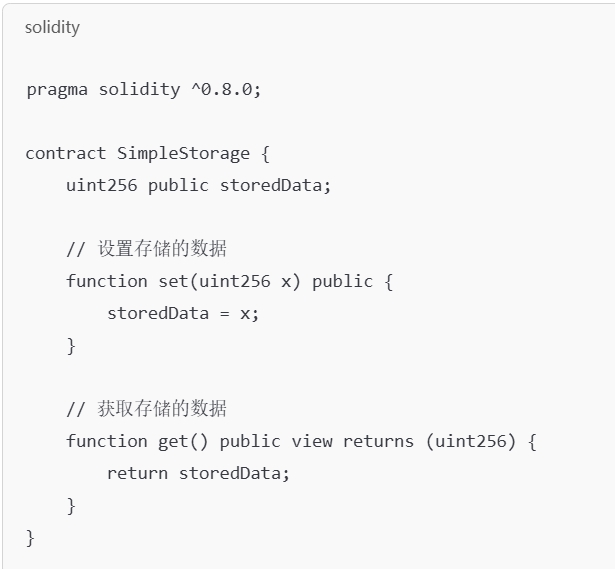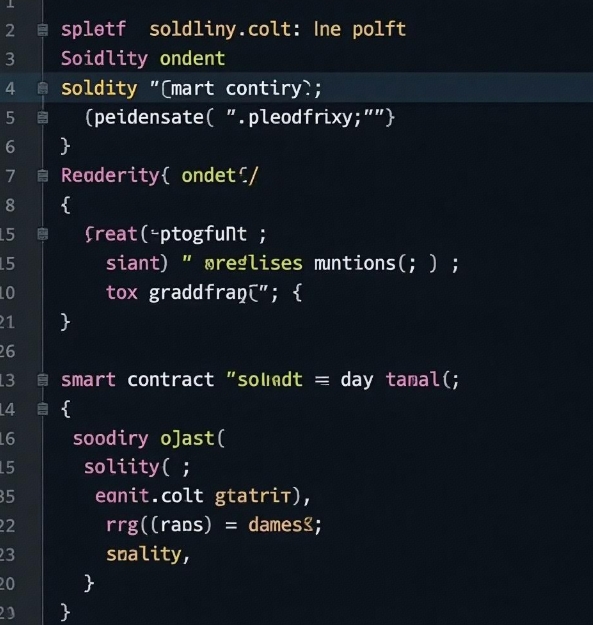Implementation and Deployment of Smart Contracts in Blockchain Development
- latest articles
- 1.DApp Development & Customization: Merging Diverse Market Needs with User Experience 2.Analysis of the Core Technical System in DApp Project Development 3.How to achieve cross-chain interoperability in Web3 projects? 4.How does the tokenization of points reconstruct the e-commerce ecosystem? 5.How to Set and Track Data Metrics for a Points Mall? 6.What is DApp Development? Core Concepts and Technical Analysis 7.Inventory of commonly used Web3 development tools and usage tips 8.Development of a Distribution System Integrated with Social E-commerce 9.Six Key Steps for Businesses to Build a Points Mall System 10.What is DApp Development? A Comprehensive Guide from Concept to Implementation
- Popular Articles
- 1.Future Trends and Technology Predictions for APP Development in 2025 2.Analysis of the DeFi Ecosystem: How Developers Can Participate in Decentralized Finance Innovation 3.From Zero to One: How PI Mall Revolutionizes the Traditional E-commerce Model 4.DAPP Development | Best Practices for Professional Customization and Rapid Launch 5.Recommended by the Web3 developer community: the most noteworthy forums and resources 6.From Cloud Computing to Computing Power Leasing: Building a Flexible and Scalable Computing Resource Platform 7.How to Develop a Successful Douyin Mini Program: Technical Architecture and Best Practices 8.Shared Bike System APP: The Convenient Choice in the Era of Smart Travel 9.How to Create a Successful Dating App: From Needs Analysis to User Experience Design 10.From Design to Development: The Complete Process of Bringing an APP Idea to Life
Over the past few years, the development speed of blockchain technology has been remarkable. Whether it's digital currencies like Bitcoin or blockchain platforms with smart contract capabilities like Ethereum, they have sparked revolutions in their respective fields. As one of the core applications of blockchain, smart contracts have become an essential component of many innovative projects. They are not merely an additional feature of blockchain technology but also provide robust support for decentralized applications (dApps). This article will delve into the implementation principles and deployment process of smart contracts, helping developers better understand this technology and offering insights for practical development.
What is a Smart Contract?
A Smart Contract is an automated protocol in blockchain technology that can automatically execute contract terms when specific conditions are met. Simply put, smart contracts are similar to clauses in traditional contracts; they are written in programming languages (such as Solidity) and stored on the blockchain. When predetermined conditions are met, the smart contract executes automatically without the need for third-party intermediaries.
One of the advantages of smart contracts lies in their immutability. Once deployed on the blockchain, all contracts cannot be altered or deleted, significantly enhancing transparency and security. Additionally, the execution of smart contracts is automated, reducing the risks and errors associated with manual operations and making transaction processing more efficient.
How Smart Contracts Work
The core of a smart contract is code. They are typically written in programming languages and deployed via blockchain platforms. Ethereum is one of the most popular smart contract platforms, with Solidity being its primary programming language. The execution and storage of smart contracts rely on blockchain technology, with the specific process as follows:
Writing the Smart Contract: Developers use programming languages like Solidity to write smart contract code and define the contract's terms and execution conditions.
Deploying to the Blockchain: The smart contract is compiled into bytecode and then deployed to the blockchain network. At this point, the contract code is permanently stored on the blockchain and accessible to all network participants.
Triggering Execution: When the contract's predetermined conditions are met (e.g., receiving a specific transaction or information), the smart contract automatically executes and completes the predefined tasks. This process is automatic and requires no human intervention.
Immutable Results: Once executed, the contract's results (e.g., asset transfers, information modifications) are permanently recorded on the blockchain, ensuring they cannot be altered or deleted.
Development and Implementation of Smart Contracts
1. Choosing a Development Environment
To develop smart contracts, the first step is to choose a suitable development environment. Ethereum is the most popular smart contract platform, and developers can use the development tools provided by Ethereum to write and deploy smart contracts. Here are some commonly used development tools and platforms:
Remix IDE: This is a browser-based development environment specifically designed for writing and testing Solidity smart contracts. Remix offers a user-friendly interface with real-time compilation and debugging, making it ideal for beginners.
Truffle Framework: Truffle is a development framework for building and testing Ethereum smart contracts, supporting functions such as writing, deploying, and testing Solidity contracts. It also integrates a powerful debugging tool to help developers quickly identify and fix issues.
Hardhat Framework: Hardhat is another popular Ethereum development framework that provides a local test network, debugging tools, and integration with other Ethereum tools, making it suitable for more complex projects.
2. Writing a Smart Contract
Smart contracts are typically written in Solidity, a high-level programming language compatible with the Ethereum platform. Below is a simple example of a smart contract:

This smart contract defines a SimpleStorage contract with a storedData variable and two functions. The set function is used to set the stored data, while the get function returns the stored data.
3. Compiling and Deploying a Smart Contract
After writing the smart contract, the next step is compilation and deployment. Smart contracts are initially written as Solidity source code and need to be compiled into bytecode that the Ethereum Virtual Machine (EVM) can understand. Once compiled, developers can deploy the contract to the Ethereum network. The deployment process generally involves the following steps:
Choosing a Deployment Platform: Developers can choose to deploy the smart contract to the Ethereum Mainnet, a test network (such as Rinkeby or Ropsten), or a local test environment (like Ganache).
Compiling the Contract: Use development tools (such as Truffle or Hardhat) to compile the smart contract, converting the Solidity code into EVM bytecode.
Deploying the Contract: Through development tools, developers publish the compiled bytecode to the Ethereum network. The deployment process requires paying a certain amount of "Gas fees."
4. Testing Smart Contracts
Testing is a crucial step before deploying a smart contract. It helps developers identify vulnerabilities and errors in the code, ensuring the contract functions correctly in real-world scenarios. Here are some common methods for testing smart contracts:
Unit Testing: By writing unit test code, developers can test the behavior of each contract function to ensure it operates correctly under various conditions.
Integration Testing: After deploying the contract on a test network, integration testing can be conducted to simulate various real-world scenarios and verify that the contract works as expected.
Security Audits: The security of smart contracts is paramount. Developers must ensure the contract is free from security vulnerabilities, such as reentrancy attacks or overflow attacks. Third-party audit tools or professional security firms can be used for this purpose.
Deployment of Smart Contracts
1. Deploying to the Ethereum Mainnet
Deploying to the Ethereum Mainnet is a critical step in putting a smart contract into practical use. During deployment, developers need to provide sufficient Ether (ETH) to cover the transaction's Gas fees. The amount of Gas required depends on the complexity of the smart contract and the current network congestion.
The deployment process typically includes the following steps:
Connecting to an Ethereum Node: Developers need to connect to the Ethereum network via a wallet (such as MetaMask) and ensure they have enough ETH to cover the deployment fees.
Choosing a Contract Deployment Tool: Tools like Truffle or Hardhat can be used via command-line interfaces to deploy the contract. These tools generate transactions and send the contract bytecode to the Ethereum network.
Waiting for Confirmation: After deployment, the transaction requires some time to be confirmed by the network. Once confirmed, the smart contract is successfully deployed on the blockchain, and other users can begin interacting with it.
2. Deploying to a Private or Test Chain
Before deploying to the Mainnet, developers often choose to deploy and test on a private or test chain first. Test networks (such as Rinkeby or Ropsten) differ from the Mainnet in that they use virtual tokens and do not involve real assets, allowing developers to simulate real-world operations and validate the contract in a test environment.
Applications of Smart Contracts
Smart contracts have a wide range of applications. Here are some common fields:
Decentralized Finance (DeFi): Smart contracts can be used to implement various financial products and services, such as lending, exchanges, options, and insurance. Through decentralized smart contracts, users can transact directly without intermediaries.
Supply Chain Management: Smart contracts can track and record each stage of a product in the supply chain, ensuring transparency and immutability of information, thereby improving supply chain efficiency.
Digital Identity Management: Smart contracts can provide users with decentralized identity authentication services, making personal information management more secure and private.
NFTs (Non-Fungible Tokens): Smart contracts form the foundation of NFT platforms, enabling the uniqueness and non-fungibility of digital assets.
Conclusion
Smart contracts are an indispensable part of blockchain technology, enhancing the efficiency and transparency of transactions through automation and decentralization. In practical development, developers need to choose the right tools, write secure and reliable code, and ensure the contract operates stably in various scenarios. As blockchain technology continues to evolve, the application prospects for smart contracts will become even broader, bringing more innovative solutions.
-

How to achieve cross-chain interoperability in Web3 projects?
With the continuous development of WEB3 technology, Web3 has gradually become an···
-

Inventory of commonly used Web3 development tools and usage tips
With the continuous development of blockchain technology, Web3 has become a hot ···
-

Web3 development trend prediction: analysis of future technology directions and application scenarios
With the gradual development of blockchain technology, the concept of Web3 has m···

 Blockchain
Blockchain











